I've split this race report summary lets call it a diary entry, into two more manageable chunks; a prologue outlining my journey to get to worlds and a main article elaborating on race week itself.
TL;DR – I had a fantastic week. I came down to Cozumel, Mexico to compete in 2 races: the Aquathlon Age-Group World Championship and the Olympic (Standard) Age-Group World Chapionship. The aquathlon on Wednesday was a novel experience that I had never competed in before, nor trained specifically for. I finished 26/32 M20-24 competitors with a 8:31 2.5km run (3:24/km), 18:40 1000m swim (1:52/100m) and 11:56 2.5km run (4:46/km). Definitely not anywhere close to my PB times, but it was a good opportunity to apprehend the climate and better plan for the Standard race on Sunday, which was my main objective of the week. I completed the standard WC triathlon in 2:10.58 with a 24:15 1250m* swim (1:56/100m), 1:00.52 40km bike (39.4kmh) and a 41:30 10km run (4:09 min/km). This put me 35 36/70 athletes in contention in the M20-24 AG. Overall, I was happy with my performance given all the circumstances and I proved to myself that I could compete with some of the best athletes in the world.
My taper to WC race week started on the flight to Cozumel, as I trained hard right up until the flight on Monday morning. A few short light runs and rides on the island kept me activated for my race Wednesday morning. For those of you unfamiliar, as I was before given the option to register for the race, the Aquathlon is a 2.5km run, 1km swim, followed by a 2.5km run - basically a duathlon with swimming instead of cycling. Swimming is not my strong suit, so I wasn’t expecting much of this race. This was just my warm-up race for fun, as my main focus was the standard triathlon. Thus, I didn’t think to specifically train for running to swimming or from swimming to running (the transitions for an aquathlon). I thought it would involve the same adaptations as swimming to biking or biking to running as in a triathlon, right? Boy was I wrong.
 My running had felt strong going into race week, so my game plan was to attempt to stick to the leaders on the first run, get through the swim (swimming is my weakest link) and hammer home the last run. I had nothing to lose so I erred on the aggressive side. As we gathered at the line, so many emotions and thoughts were buzzing through my mind. It’s tough to put it into words, but it was sort of a mix of pride, intimidation, nervousness, and excitement with a little kick of adrenaline. I was stood there facing the acronyms AUS, NZL, RSA, BRA, MEX, POR, USA, GER, GBR, among others, hearing all kinds of dialects and accents. I think that’s when it really sunk in, I was standing among some of the most talented athletes in the world. Some travelled across half the world to toe the line. I could not believe that I was amid them. The magnitude and significance of the Grand Final had hit me.
My running had felt strong going into race week, so my game plan was to attempt to stick to the leaders on the first run, get through the swim (swimming is my weakest link) and hammer home the last run. I had nothing to lose so I erred on the aggressive side. As we gathered at the line, so many emotions and thoughts were buzzing through my mind. It’s tough to put it into words, but it was sort of a mix of pride, intimidation, nervousness, and excitement with a little kick of adrenaline. I was stood there facing the acronyms AUS, NZL, RSA, BRA, MEX, POR, USA, GER, GBR, among others, hearing all kinds of dialects and accents. I think that’s when it really sunk in, I was standing among some of the most talented athletes in the world. Some travelled across half the world to toe the line. I could not believe that I was amid them. The magnitude and significance of the Grand Final had hit me.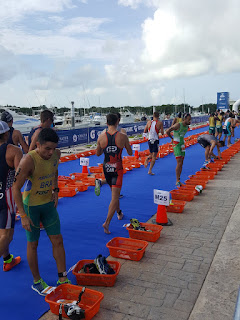 |
| Aquathlon Transition - Looks weird without the bikes, huh? |
 |
| Finish line for the 2016 Aquathlon World Championships - no arms up, no smile. |
After chatting to a few other Canadians around the island over the following days about their experience, I formulated a hypothesis.
1. I know I may have gone out a bit too hard, which obviously led to my fatigue. That may have just been attributed to the jitters and adrenaline of a mass run start and the atmosphere of the crowd that overloaded my sense to run within myself. I can accept that.
2. This is the main key to my struggle during the race, I believe. When swimming, especially longer distances, you typically have a relatively lower HR (compared to other endurance activities) as well as a very slow, rhythmic breath rate. My heart rate is around 140-150 BPM and a breath every 3 strokes (or 1 breath every second or two and you must hold your breath between inhales. We can call this discontinued breathing, so-to-speak). Conversely, while running at a close to max pace (as was my case), your HR is close to max and your breathing is very rapid. My HR is typically 170-190 during hard intervals and my breathing is very fast and deep (almost a panting or continuous breathing). The problem that I came to realize is during a normal triathlon, you start in the water where you can slowly elevate your HR and BR to active levels. Then you go on to the bike and run where your HR and BR can increase at will. However, in an aquathlon, after my hard run, my HR was shot way up and my BR was probably out of control (especially in the cooking Mexican heat). To dive into the water and start swimming, my BR had to instantaneously reduce to a slow and rhythmic rate. That was what I was not prepared for. With my HR still so high, and my BR being forced to reduce and my muscles still striving for oxygen to function and to recover after the fast run, my body went into an oxygen debt. I believe it would be akin to running an all out 3km running race while holding each breath for 5 seconds (maybe? I have no objective proof for this). I think to better prepare for this, my training adaptations may have come from obviously practicing hard runs to swims (to reduce my HR quicker), or to pull up from the last 500m-750m of the run and let my HR lower a bit to prepare for the swim.
It took me a bit of time to swallow the events of the aquathlon but in the end it was a great experience and a great learning opportunity leading up to the big race on Sunday.
In the three days between races, I took full advantage of the group training sessions and tried to better acclimatize to the heat.
 |
| Crazy swim start practice with ~100 other Canadians |
 My race wave started at 6:45am. Transition was open between 5:00 and 6:30 to set up your kit for the race. To avoid the hassle of finding a cab at 5:00am, we rented scooters the previous day and drove ourselves to the race site. Zipping down the main road in the pitch black at 5:00am definitely woke me up with a fist full of wind in my face. It sort of gave me time to think about the race and get my head in the zone. Luckily I got to the race site unharmed and on 2 wheels. Race prep and warm-up went smoothly and before I knew it, I was standing in the corral for the first wave of the 2016 ITU Age Group World Championship. Whereas there were 30 people from primarily 4 countries in the aquathlon wave, here, there were over 100 athletes from over a dozen countries. The atmosphere was unreal. So many thoughts and emotions were running through my head, but unlike during the aquathlon, I feel they were more subdued and I was more in the zone and ready to race.
My race wave started at 6:45am. Transition was open between 5:00 and 6:30 to set up your kit for the race. To avoid the hassle of finding a cab at 5:00am, we rented scooters the previous day and drove ourselves to the race site. Zipping down the main road in the pitch black at 5:00am definitely woke me up with a fist full of wind in my face. It sort of gave me time to think about the race and get my head in the zone. Luckily I got to the race site unharmed and on 2 wheels. Race prep and warm-up went smoothly and before I knew it, I was standing in the corral for the first wave of the 2016 ITU Age Group World Championship. Whereas there were 30 people from primarily 4 countries in the aquathlon wave, here, there were over 100 athletes from over a dozen countries. The atmosphere was unreal. So many thoughts and emotions were running through my head, but unlike during the aquathlon, I feel they were more subdued and I was more in the zone and ready to race.  |
| Race day could have ended very badly, very quickly! |
A common thought that I always have on the start line of or night before a big race is “did I train enough?”. I always question my preparations and training. I think back to that one Sunday where I slept in and couldn’t make my long run or when I was just simply too tired to go for a ride. I start to worry that I hadn’t trained enough or didn’t train hard enough even though deep down I know I am always prepared to the best of my abilities. Once I start racing, I feel fine and confident again, but the nerves before the race are the worst. This time, for my biggest race ever, I had no such feelings. I spent the summer training with the UW varsity swim team 3 times per week and logged all of my bike and run km’s on Strava. That was head and shoulders more than I have ever swam before, so I was confident in my swim. According to Strava, since January, I logged 3,677km of cycling at 5 rides per week and 507km of running at 4 times per week. These stats don’t include my indoor training on the spin bikes or treadmill runs where the bulk of my winter training was. This year I focused solely on the Olympic distance so my quality work was relatively short and intense. I had no doubt in my mind that I had prepared all that I could for this race. Standing in the corral, surrounded by some of the best athletes in the world, I thought back to a quote that my grade 9 science teacher, Mr. Levack, told my class before our first ever high school final: “Relax, there is no more preparation that you can do now. All of your studying has been done. All you can do it focus on the task at hand and do your best”. Those words have stuck with me and are so relevant to many aspects of life.

At exactly 6:40 we were called down to the paddock starting line and we hopped in. It was a breezy 27 degrees. Due to the strong tides/currents in the water that morning, the swim was announced to have been shortened to 1250m! I thought this benefitted me, since swimming is my weak discipline, however I was wrong. The swim course was a rectangular box with its longest side parallel to the shore, so most of the swimming was done in a north-south/south-north direction. The current was flowing such that the longest straight section of the swim was against the current. I didn’t feel to beat up by the waves but the swim was definitely a hectic one. The tides had affected me since I felt really strong in the swim, but ended up finishing close to a minute slower than my 1500m best, despite the shortened course. I had never been in a swim so tight and so aggressive for so long. Typically swims disperse after the first few hundred meters, but here people in my group were clawing each other right to the exit ramp. I feel the shortened swim benefitted the stronger swimmers, who knew how to adapt to the stronger tides and could push through. The fastest swimmer still swam a 17:12. On a side note, apparently the currents got so bad towards the later waves, athletes were swimming and not making up any ground - some said they were going backwards! Some swims clocked in at 55 minutes! Some in the last waves even had to be pulled out of the water because they could not physically make it to shore. Luckily, they were allowed to finish the race, given the circumstances, albeit with a huge asterisk beside their time.

 Out of the water and on to the bike, The Cozumel bike course is on a dedicated bike path down the western side of the island. It is pancake flat with minimal turns. My game plan was the same as from TTF: manage the swim, ride over 40kph on the bike and run a sub-40 run. We had a tailwind out and head wind in. With the anticipated heat on the run, I decided that I was going to sit up a little for the last ~5km of the bike to let my legs recover a little bit. As planned, I took one eLoad gel at the turnaround and had 1 bottle of water on the bike and 1 bottle of eLoad Endurance formula, which I polished dry.
Out of the water and on to the bike, The Cozumel bike course is on a dedicated bike path down the western side of the island. It is pancake flat with minimal turns. My game plan was the same as from TTF: manage the swim, ride over 40kph on the bike and run a sub-40 run. We had a tailwind out and head wind in. With the anticipated heat on the run, I decided that I was going to sit up a little for the last ~5km of the bike to let my legs recover a little bit. As planned, I took one eLoad gel at the turnaround and had 1 bottle of water on the bike and 1 bottle of eLoad Endurance formula, which I polished dry.
I settled into the bike averaging in the low 40’s with an Aussie, a Brit and the lead woman from Team GB who has swam up the 3 minute stagger deficit, making sure to keep a 12 meter drafting box between myself and the rider ahead. I held that pace, until the turn around where the slight headwind lowered my speed slightly to 38-40kph. As planned, around 5km I started to shut it down and rode a less aggressive pace to T2.
I am not going to get into a discussion on drafting in non-draft legal racing as I agree with the two recent posts by both Lionel Sanders and Kristen Marchant, who both explained the topic meticulously. All I will say is from what I saw and heard from other athletes and spectators, it didn’t seem like everyone was holding a 12 meter drafting box, specifically at the sharp end of the race.

My goal was to ride a sub-hour bike split. Given the climate, wind and decision to pull up for the last ~10 minutes, finishing 56 seconds up is an objective accomplished in my books.
Like the bike, the run was also pancake flat, except the course was totally exposed to the sun with only about 100m worth of tree shade over the 2x5km loops. My plan here was to take out the first 6km at a comfortable pace and hammer home the last 4km (depending on how I felt). It was a very technical course, but well marked and easy to follow. The majority of the road was slippery, patterned concrete with a kind of cement shoulder that provided a bit more grip (especially when cornering). On a pretty uneventful run, I got to the 6km mark on schedule averaging around 4:00/km. At every aid station, I grabbed all of the water I could and jammed ice into every crevice I could find. At the 1km/6km mark, however was a very long 2-2.5km stretch of course in the middle of the highway, with no tree shade and direct exposure to all of the elements. Just as I started to pick up my pace, as planned, I began to fall apart. The heat was finally taking its toll on me and I felt myself begin to overheat and fatigue. All of the water and ice that I could grab wasn’t enough to cool me down and my pace slowly reverted modestly to 4:20min/km. It was a struggle, but to my surprise the group that I had been running with also slowed the pace, probably a coincidence. I was met with a spur of the moment dilemma: do I push through to hold my pacing schedule and risk blowing up, or continue to run at a relative comfortable pace and unload whatever I had left for the finish?
 |
| Headed out of T2 |
 |
| Second lap, still feeling good |
 |
| IT WAS HOT! |
 Up until this point, I was running a very net positive race. By that I mean I was consistently making up ground on the field after the swim. On the bike, 1 person in my AG passed me, while I passed a handful. On the run, 1 or 2 people in my AG passed me, while I passed even more than on the bike. On the run, I noticed a lot of people ahead of me walking and even stopping at the side of the course. The heat was clearly impacting a lot of people very severely (as seem here). Clearly, I wasn’t running quite as fast as him nor had as much at stake, but I feel in hindsight, had I been pushing the same relative percent max effort, I may have experienced the same fate. I erred on the conservative side (learning from my aquathlon blow up) and controlled my pace through km 8 and 9. In the final km I knew where I was and threw down every last bit of energy that I had. In the final 500m, even though my speed may not have shown it, I felt weightless. I crossed the line with the feeling and emotions that I had dreamt about feeling. This time arms up, smile on my face, I was ecstatic.
Up until this point, I was running a very net positive race. By that I mean I was consistently making up ground on the field after the swim. On the bike, 1 person in my AG passed me, while I passed a handful. On the run, 1 or 2 people in my AG passed me, while I passed even more than on the bike. On the run, I noticed a lot of people ahead of me walking and even stopping at the side of the course. The heat was clearly impacting a lot of people very severely (as seem here). Clearly, I wasn’t running quite as fast as him nor had as much at stake, but I feel in hindsight, had I been pushing the same relative percent max effort, I may have experienced the same fate. I erred on the conservative side (learning from my aquathlon blow up) and controlled my pace through km 8 and 9. In the final km I knew where I was and threw down every last bit of energy that I had. In the final 500m, even though my speed may not have shown it, I felt weightless. I crossed the line with the feeling and emotions that I had dreamt about feeling. This time arms up, smile on my face, I was ecstatic.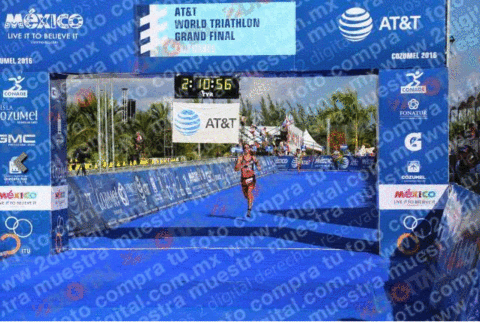 |
| My "celebration" didn't quite pan out as well in the photos |
 At this point, I could go into all kinds of analysis of the splits and statistics of the race. In the simplest of ways, I was 6 minutes slower than my distance PB, despite the botched swim (where no real comparisons can be made), heat and moderately busy week preceding the race. It is tough to compare the swim due to the wetsuit illegal swim, salt water, tides, shortened course, etc. My bike was 58 seconds slower than planned and my run 90 seconds slower than planned. Counting how many things could have gone wrong race day, I have to chalk that one up as a win. I was never going into the race expecting to win or even come top 10. My objectives were to race for the experience of racing with some of the top athletes in the world. My finishing time was 2:10.58, which I’ll be the first to admit isn’t blazing fast by any means but relative to the field, finishing 36/70 far exceeded my expectations.
At this point, I could go into all kinds of analysis of the splits and statistics of the race. In the simplest of ways, I was 6 minutes slower than my distance PB, despite the botched swim (where no real comparisons can be made), heat and moderately busy week preceding the race. It is tough to compare the swim due to the wetsuit illegal swim, salt water, tides, shortened course, etc. My bike was 58 seconds slower than planned and my run 90 seconds slower than planned. Counting how many things could have gone wrong race day, I have to chalk that one up as a win. I was never going into the race expecting to win or even come top 10. My objectives were to race for the experience of racing with some of the top athletes in the world. My finishing time was 2:10.58, which I’ll be the first to admit isn’t blazing fast by any means but relative to the field, finishing 36/70 far exceeded my expectations. |
| Post-race refreshments! |
I attribute much of my success to my heat training and advice from Cody Beals, who shared some of his heat training protocol wisdom with me earlier in the year. I won’t dwell into the details of what Cody prescribed, but I did wear a long sleeve or sweater for most workouts throughout the year (indoor and outdoors) as well as take full advantage of my 2 pairs of sauna suits during workouts as well. Everyone looked at me like I had 3 heads in this record high summer and at the time, I had no idea if any of it would have been beneficial come race day. It did, I suppose. Even though km 8 and 9 of the run were slower, it didn’t really drastically change my pace; ~20 seconds per kilometer. It’s a far cry from hitting the wall. I feel the heat training allowed me to control the race better and if anything, delayed my suffering to the heat. Even just standing and lounging around the island, people whom I was with were complaining about the heat and I felt totally cool.
 |
| Woke up Alexander Dos Santos one morning with a leg full of wax strips. Still the hairiest triathlete I know! |


 I would like to give a huge thank you to my sponsor 3Sixty5 Cycling for their continued support of my athletic endeavors. I raced on a set of Platinum 88 wheels with 3Sixty5’s proprietary hubs. Also to my countless training partners who pushed and paced me through crazy workouts all year long. Lastly to my family, who have supported me through this long and arduous journey.
I would like to give a huge thank you to my sponsor 3Sixty5 Cycling for their continued support of my athletic endeavors. I raced on a set of Platinum 88 wheels with 3Sixty5’s proprietary hubs. Also to my countless training partners who pushed and paced me through crazy workouts all year long. Lastly to my family, who have supported me through this long and arduous journey.
Just like after my Ironman, I am at a loss at where to go from here. I feel like I have achieved all of my goals and have no idea where to focus my attention on next. I have spent the last 15 months swimming, biking or running in my down time in preparation for Cozumel. I think I’ll put the bike and goggles away for a while and focus on the cross country season. Then I will sit down, assess my grad school schedule and pick out my next target. I am a person who likes to be driven by goals and achievements. I always like to be working towards something; a tangible, definite end. Previously, it was my Ironman, then Worlds. With no goal set in my scope, I feel lost. It’s a weird feeling. They say it’s not about the destination; it’s about the journey taken to get there. It’s the journey that drives me everyday, and it always starts with the first step.
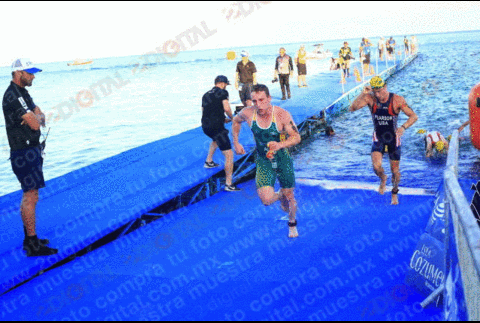

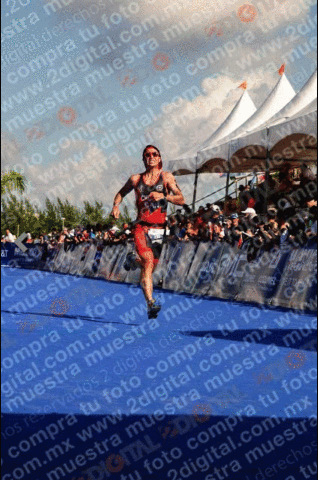
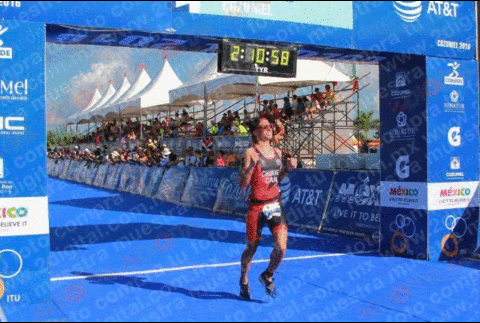


No comments:
Post a Comment